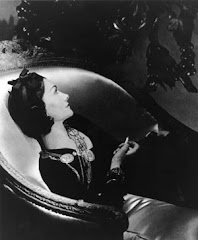Thursday, 1 November 2007
If you can't go shopping then read about shopping
Posted by
Linda Grant
at
21:24
1 comments
![]()
![]()
![]()
![]()
Labels: Literature, Published work, Shopping
Guilt
* How many Jewish mothers does it take to change a light bulb? None, I'll just sit here alone the dark
Posted by
Linda Grant
at
09:16
0
comments
![]()
![]()
![]()
![]()
Labels: Opinions, Philosophy, Theology
What do these three men have in common?
That, said my lunch companion, is Alexander McQueen.
And a spasm of pure rage passed through me. Who was this fat bastard to tell women that they were obese if they couldn't fit into a size 10? To make clothes that half the population couldn't wear? I am tired of fat men telling non-skeletal women that they don't exist. Granted, McQueen, like Lagerfeld, with the assistance of the finest trainers money can buy and no obligation to prepare family meals three times a day, have slimmed down, or in the case of Lagerfeld, turned himself into his own corpse, but fashion is full of fat men (sorry Alber, I really love you in every other way) giving normal-sized women an inferiority complex.
I had my picture take a couple of weeks ago to go with a magazine piece I'm doing . There was a photographer, a picture editor, a make-up artist and the manager of Hobbs all involved in this operation, and after the make-up artist had bemoaned that she couldn't find a pair of trousers to fit her in Zara, the photographer said that one her friends was a plus-sized model. 'What's plus size?' I asked. It's size 12 (US8) she told me.
Myself, I'd put every man in fashion who weighs over 150 pounds on the Atkins diet. And don't come back until you can fit into skinny jeans.
Posted by
Linda Grant
at
06:49
9
comments
![]()
![]()
![]()
![]()
Labels: Alber Elbaz, Alexander McQueen, Hobbs, Karl Lagerfeld, Opinions, Zara
Reader, she married him, in Vera Wang

I have always been interested in clothes, but only in the past few years have I actually begun to think about them, in a serious way. It all started with this piece in UK Vogue, which I wrote in 2004. Vogue doesn't put any of its features online so I've been waiting since this blog began for my webmeister to turn the text that's stored on my computer into a PDF and then a link. And here it is.
It's about how clothes have been treated by literature, though the ages, from Chaucer (enthusiastically) through Jane Austen (with disdain) to Proust (love and reverence) to Judith Krantz (max out your cards). I'm looking at how an author uses clothes to delineate character:
What did Hamlet wear? Black. And the Wife of Bath, riding to Canterbury? Red stockings and new shoes. Samuel Richardson’s Clarissa? A pale primrose morning gown, with a recurring silver and gold pattern of violets, accessorised with diamond earrings, blue satin buckled shoes and black velvet gloves. Proust’s Duchess? The first Fortuny dresses. Jane Eyre? Black and pearl grey silk, despite Mr Rochester’s insistence that should take the pink satin, which made her feel like a houri in a Turk’s seraglio.
Read on
Posted by
Linda Grant
at
06:38
0
comments
![]()
![]()
![]()
![]()
Labels: Literature, Published work
Thought for the day
'When I see people dressed in hideous clothes that look all wrong on them, I try to imagine the moment when they were buying them and thought, "This is great. I like it. I'll take it."' Andy Warhol
Posted by
Linda Grant
at
00:52
0
comments
![]()
![]()
![]()
![]()
Labels: Critical faculties, Thought for the day







